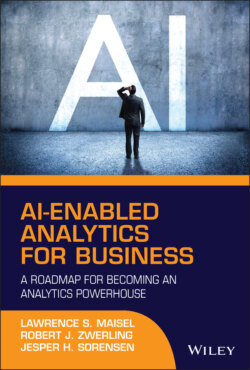Читать книгу AI-Enabled Analytics for Business - Lawrence S. Maisel - Страница 20
HUMAN JUDGMENT AND DECISION-MAKING
ОглавлениеIn business, human decision-making does not always optimize performance because it is vulnerable to bias and intuition: that is, gut feel. We are naturally intuitive about the future but quantitatively limited to calculate what the future probably can be. We react to events and rely on experience to “guide” us to a decision. We also may have a personal want or need that influences and impacts our decisions.
As such, we must first understand how nature has wired us to make decisions before we can appreciate and accept how analytics can contribute to enhancing decision-making that can lead to improved business performance. The need to balance our instinctive judgment with AI for decisions is necessary to fulfill the potential value of analytics in business and avoid the shortcomings associated with traditional decision-making.
The research of Kahneman and Tversky, who received the Nobel Prize for Economics in 2002, produced a ground-breaking understanding of human judgment and decision-making under uncertainty. Their research is viewed as one of the most influential social science behavioral insights of the past century. It challenged the notion held by many economists that the human mind is unconsciously rational.
Kahneman authored a book, Thinking, Fast and Slow; the central thesis is the interplay between what he terms System 1 and System 2 thinking.3 In System 1, a person has an instinctual response that is automatic and rapid and has been shaped by experience and expertise. For example, how much is 2 plus 2? Hopefully, you said 4. Your response was immediate and almost instinctive because, over many years, this simple answer has always been the same. In effect, System 1 seeks coherence and applies relevant memories to explain events or make decisions.
System 2 is invoked for more complex, thoughtful reasoning and is characterized by slower, more rational analysis but is “prone to laziness and fatigue.” If you want to conduct your own experiment along these lines, ask someone to write down the results of a hypothetical sequence of 20 coin flips. Then ask the person to flip a coin 20 times and write down the results. The actual flips will almost certainly contain streaks of only heads or tails—the sorts of streaks that people do not think a random coin produces on its own. This kind of misconception leads us to incorrectly analyze all sorts of situations in business, politics, and everyday life.
Further, the research of Kahneman and Tversky revealed previously undiscovered patterns of human irrationality: the ways that our minds consistently fool us and the steps we can take, at least some of the time, to avoid being fooled. They used the word heuristics to describe the rules of thumb that often lead people astray.
One such rule is the halo effect, in which thinking about one positive attribute of a person or thing causes observers to perceive other strengths that are not actually there. For example, a project team was discussing the status of a new marketing campaign. The campaign was led by Billy, who had a reputation for delivering successful campaigns. Team members were asked to give their assessment of progress and, recognizing Billy’s past successes, gave positive evaluations. This reflected the halo effect in that the past successes extended to this project without any factual basis other than Billy’s reputation.
This work has led to advances in individual behavior. It is full of practical little ideas like “No one ever made a decision because of a number”; Kahneman has said, “They need a story.” Or Tversky’s theory of socializing: because stinginess and generosity are both contagious, and because behaving generously makes you happier, surround yourself with generous people.
The research has clarified how decisions are made and underlying influences that can impact decisions. These influences are inherent in group interactions and individual biases, which are key to understanding the balance between human judgment and analytics in decision-making.
